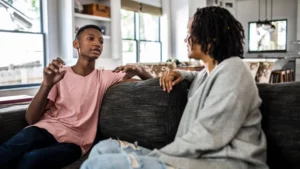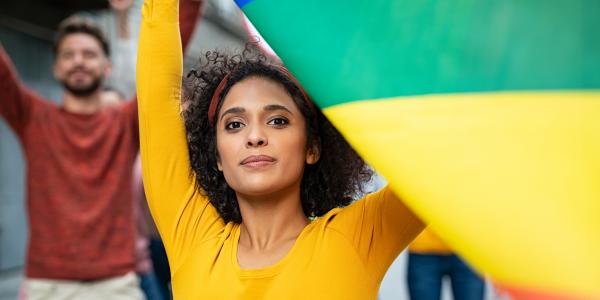In a world that increasingly prides itself on acceptance and equality, there still exists an array of complexities for young people who identify as Lesbian, Gay, Bisexual, or Transgender (LGBT). These complexities are intricately woven into the fabric of their daily lives, often starting at a tender age. They can span from issues of self-acceptance and the coming out process to bullying, discrimination, and access to proper healthcare and support systems. This blog aims to spotlight these types of common LGBT youth issues while offering resources and inspiring dialogue that could contribute to potential solutions.
Contents
What Are Some Common LGBT Youth Issues?
 LGBT youth face a range of challenges, many of which are exacerbated by societal norms and expectations that don’t accommodate their identities and experiences. Here are some common issues faced by LGBT youth:
LGBT youth face a range of challenges, many of which are exacerbated by societal norms and expectations that don’t accommodate their identities and experiences. Here are some common issues faced by LGBT youth:
Coming Out
Coming out, or revealing one’s sexual orientation or gender identity, is a deeply personal process that varies greatly from person to person. For some LGBT youth, coming out can be a freeing experience that brings relief and a sense of authenticity. However, many also face negative reactions ranging from mild discomfort to severe rejection, bullying, or even violence. Fear of these negative outcomes can cause a lot of stress and anxiety. For some, the process of coming out is ongoing, as they meet new people and enter new environments throughout their lives.
Acceptance
Acceptance is a multifaceted issue for LGBT youth. On one level, there’s self-acceptance, which can be challenging given societal norms and expectations about gender and sexuality. Many LGBT youth internalize these norms and develop feelings of shame or guilt about their identities. On another level, there’s acceptance from others – from family, friends, classmates, and society at large. Lack of acceptance can lead to social isolation, rejection, and discrimination.
Discrimination and Bullying
Discrimination against LGBT youth can manifest in a variety of ways, including unequal treatment in school, at work, or within the community, as well as bullying, both physical and verbal. Online harassment is also a significant issue. The negative impacts of this discrimination and bullying can range from decreased academic performance and low self-esteem to more serious mental health issues.
Mental Health
LGBT youth are at higher risk of mental health problems due to a range of factors. These include the stress of dealing with stigma and discrimination, the challenges associated with coming out, and the struggle for acceptance. Research has shown that LGBT youth are particularly at risk of depression, anxiety, and suicidal thoughts or behaviors. Moreover, LGBT youth may be less likely to seek help due to fear of stigma or discrimination within the healthcare system.
Healthcare Access
LGBT youth often face barriers when it comes to accessing healthcare. These can include outright discrimination, lack of understanding or training among healthcare providers, and absence of appropriate services. Transgender youth in particular often face difficulties in accessing gender-affirming healthcare, such as hormone therapy or surgery. Additionally, mental healthcare is a critical need for many LGBT youth, and they may struggle to find providers who are affirming, understanding, and knowledgeable about their specific experiences and needs. Lack of comprehensive, inclusive sex education can also lead to increased risks related to sexual health.
Homelessness
LGBT youth are significantly overrepresented in the homeless population. This is often due to family conflict arising from their sexual orientation or gender identity, leading to either running away or being kicked out of their homes. Once homeless, LGBT youth are at increased risk of violence, exploitation, and health problems. They can also struggle to access services due to discrimination or lack of understanding by providers.
Education and School Environment
School can be a challenging environment for LGBT youth. Bullying and discrimination can lead to lower academic performance and school attendance. There’s also a lack of inclusive sex education in many schools, which often fail to provide information relevant to LGBT students — like safe sex information for same-sex couples or understanding of gender identities. Additionally, some schools lack policies protecting LGBT students from discrimination, and not all schools have supportive resources like Gay-Straight Alliances.
Legal Issues
 Legal protection for LGBT individuals varies widely around the world and even within countries. Some LGBT youth live in jurisdictions where they enjoy legal protections against discrimination, and where their rights to things like marriage and adoption are recognized. However, others live in places where they face legal discrimination, or where their identities or behavior are criminalized. Legal issues can affect everything from school and work rights to healthcare access and personal safety.
Legal protection for LGBT individuals varies widely around the world and even within countries. Some LGBT youth live in jurisdictions where they enjoy legal protections against discrimination, and where their rights to things like marriage and adoption are recognized. However, others live in places where they face legal discrimination, or where their identities or behavior are criminalized. Legal issues can affect everything from school and work rights to healthcare access and personal safety.
Identity Erasure and Invisibility
Some identities within the LGBT community are less recognized and understood, both within and outside the community. For example, bisexual individuals often face biphobia and erasure, being accused of being “confused” or “in a phase”. Non-binary and other gender-diverse individuals often face similar issues, as their identities are often misunderstood or not recognized. This lack of recognition can lead to invisibility, lack of acceptance, and lack of access to appropriate resources and support. It can also contribute to mental health issues and feelings of isolation.
It’s important to remember that while these challenges are common, they’re not universal, and each individual’s experience is unique. The situation is also improving in many places, thanks to the hard work of activists and allies fighting for acceptance, understanding, and equality.
How To Cope Up LGBT Youth Issues?
 Addressing and coping with the issues faced by LGBT youth involves both individual and collective efforts. Here are several strategies that can be helpful:
Addressing and coping with the issues faced by LGBT youth involves both individual and collective efforts. Here are several strategies that can be helpful:
- Supportive Networks
Building a network of supportive individuals is crucial. This can include friends, family members, teachers, or mentors who are accepting and supportive of the youth’s identity. Support groups, either online or in-person, can also provide a space for sharing experiences and advice.
- Professional Help
Mental health professionals, especially those with experience in LGBT issues, can provide important support. This could include counseling or therapy, support groups, or in some cases, medication. Medical professionals can also assist with health issues, including those specific to LGBT youth like gender transition-related healthcare for transgender youth.
- Education
Learning more about one’s own identity and the broader LGBT community can be empowering. This can include reading books, watching films, attending workshops or lectures, or participating in LGBT events. Understanding one’s rights, both legally and in specific settings like school or work, can also be important.
- Self-Care
Practices that promote physical, mental, and emotional well-being are essential. This could include regular physical activity, a healthy diet, sufficient sleep, mindfulness or meditation, and hobbies or activities that bring joy and relaxation.
- Advocacy and Activism
Getting involved in advocacy or activism can be a powerful way to combat discrimination and push for change. This can range from personal advocacy like standing up against bullying, to broader activism like participating in marches, lobbying for policy changes, or volunteering with LGBT organizations.
- Safe Spaces
Seeking out or creating safe spaces where LGBT youth can express themselves freely is essential. This can include LGBT youth groups, inclusive religious congregations, or clubs and organizations that affirm and celebrate diversity.
- Online Resources
The internet can provide a wealth of resources, including informational websites, online support groups, and social media communities. These can offer advice, support, and a sense of connection to a wider community.
Remember, each person’s journey is unique, and what works for one person might not work for another. The most important thing is to respect each individual’s self-identified needs and experiences.
Conclusion
In conclusion, the LGBT youth issues are multi-dimensional, mirroring personal journeys of self-discovery as well as the broader societal attitudes and norms. Despite the challenges, it’s crucial to remember that these experiences do not define the entirety of an LGBT individual’s life, but rather represent parts of a larger personal narrative.
Ultimately, the goal should not just be about coping with challenges but striving towards a society that fully accepts and celebrates the diversity of human identities. It’s a journey we are all on together, and every step forward, no matter how small, brings us closer to a world where every individual feels safe, accepted, and loved, regardless of their sexual orientation or gender identity.
Life may sometimes be challenging for people from LGBTQ community, but Online LGBTQ Counseling can help. Get experienced LGBTQ therapists at PrideMantra: Book a trial LGBTQ therapy session


